 Bartok Cabin. Adirondack Daily Enterprise, February 2, 1996. Historic Saranac Lake Collection.
Bartok Cabin. Adirondack Daily Enterprise, February 2, 1996. Historic Saranac Lake Collection. 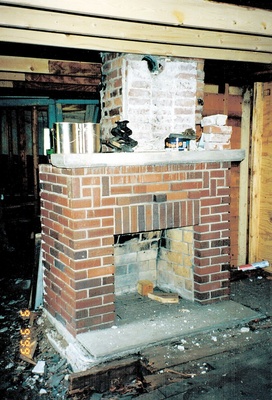 Bartok Cabin fireplace, before restoration. Courtesy of Mary Hotaling, 1999.
Bartok Cabin fireplace, before restoration. Courtesy of Mary Hotaling, 1999. 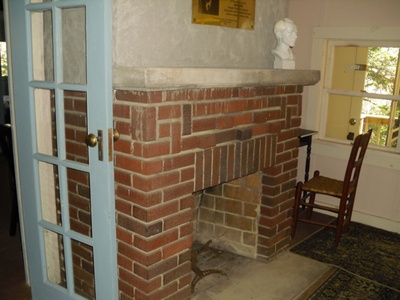 Bartok Cabin fireplace, after restoration. Historic Saranac Lake Collection, 2013.
Bartok Cabin fireplace, after restoration. Historic Saranac Lake Collection, 2013.  Bartok Cabin dining room area, before restoration. Courtesy of Mary Hotaling, 1999.
Bartok Cabin dining room area, before restoration. Courtesy of Mary Hotaling, 1999. 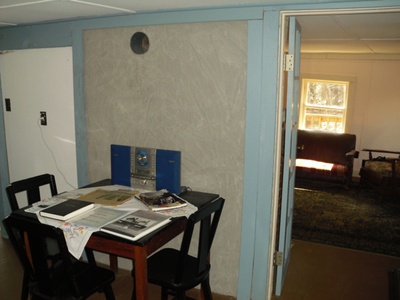 Bartok Cabin dining room area, after restoration. Historic Saranac Lake Collection, 2013.
Bartok Cabin dining room area, after restoration. Historic Saranac Lake Collection, 2013. 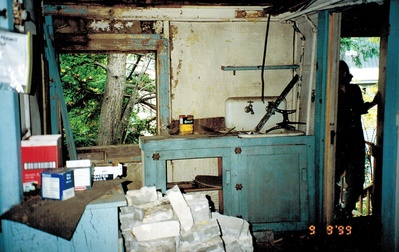 Bartok Cabin kitchen, before restoration. Courtesy of Mary Hotaling, 1999.
Bartok Cabin kitchen, before restoration. Courtesy of Mary Hotaling, 1999.  Bartok Cabin kitchen, after restoration. Historic Saranac Lake Collection, 2013.
Bartok Cabin kitchen, after restoration. Historic Saranac Lake Collection, 2013. 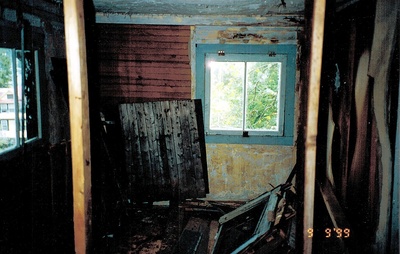 Bartok Cabin bedroom, before restoration. Courtesy of Mary Hotaling, 1999.
Bartok Cabin bedroom, before restoration. Courtesy of Mary Hotaling, 1999. 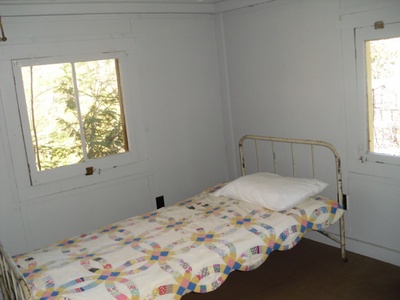 Bartok Cabin bedroom, after restoration. Historic Saranac Lake Collection, 2013.
Bartok Cabin bedroom, after restoration. Historic Saranac Lake Collection, 2013. 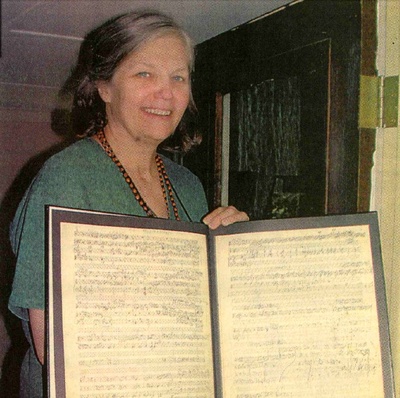 Mary Hotaling displays pages of Bartok's Viola Concerto, one of his final pieces written during his stay in the cabin in 1945. Adirondack Daily Enterprise, July 5, 2003.
Mary Hotaling displays pages of Bartok's Viola Concerto, one of his final pieces written during his stay in the cabin in 1945. Adirondack Daily Enterprise, July 5, 2003.
Address: 58 Riverside Drive
Old Address: 89 1/2 Riverside Drive
Year built: probably 1920s or 1930s
Adirondack Daily Enterprise, February 2, 1996
By MARY B. HOTALING Special to the Enterprise
SARANAC LAKE - In 1945 the great Hungarian composer Béla Bartók spent the last summer of his life in Saranac Lake, writing two pieces, his Third Piano Concerto and his Viola Concerto. Fifty years later. Bartók's reputation has soared, but the cabin at 89 1/2 Riverside Drive where he stayed is near collapse.
Bartók, 59, arrived in the United States with his wife Ditta late in 1940; their teen-age son Peter followed later. They had voluntarily exiled themselves from their home in Hungary, where Bartók's music is rooted, rather than live under the rule of the approaching Nazis, whom Bartók despised. Though not yet well-known in the United States, Bartók was famous in Hungary as a pianist, a composer and a collector of the ancient native folk songs of Eastern Europe. In New York he had a position at Columbia University studying and transcribing Harvard's Milman Parry Collection of Serbo-Croatian folk songs in a sound-proof room. It was work that Bartók loved, and he was the best possible person to do it, but the money supporting his research was uncertain and renewed only six months at a time. Because of the war, his funds in Hungary were not available to him.
At the same time that he was having difficulties with money, his health was also declining. The American Society of Composers, Authors and Publishers (ASCAP) stepped in to provide the best doctors and hospitals. Bartók's illness was at first thought to be a recurrence of the tuberculosis he had had as a young man, and one of his doctors in New York was Edgar Mayer, well known here as the director of Will Rogers Hospital. Later a diagnosis of leukemia was made, but as there was no effective treatment at that time, the gravity of his condition seems to have been downplayed to him.
Twenty-five years later. Dr. Mayer wrote a remembrance of Bartók as "very soft spoken and talking very little. He never complained!! With high fever up to 102° - 103° he sat up writing music from his head, composing from memory. He hated to be disturbed even by his doctor, he did not believe we knew what was wrong with him anyhow.
"To compose he needed great silence. He stuffed his ears with ebony earstoppers. One day, one of his ebony ear pieces got lost and he was in great distress. I had the fortunate idea of trying an earpiece from my stethoscope. This he could not forget, it was the greatest good deed I did for him. It helped him more than any medical service I gave him."
Mayer and his colleague Dr. Israel Rappaport sent Bartók to Saranac Lake for the summer of 1943. That summer and the next, on the recommendation of Dr. Henry Leetch, the Bartóks stayed with Mrs. Margaret Sageman, who owned a large cure cottage at 32 Park Avenue, and lived in a smaller bungalow behind it. In less than two months, Bartók composed the Concerto for Orchestra.
When the Bartóks returned to Saranac Lake in 1945, they moved into a four-room cabin at 89 1/2 Riverside Drive. Mrs. M.A. Levy, with whom the Bartóks had become friends in previous summers, had helped them find it, next door to her house at 93 Riverside Drive. The cabin stood in the back yard of a house rented by Maks Haar, who worked for Lederle, and his wife, Ida Weinstock Haar, who was raised in Saranac Lake. For $15 a month, the Haars sublet the cabin to the Bartóks, who inscribed the Haars' guest book: "We are happy indeed to stay in this wonderful quiet place."
It is not known when the rustic cabin was built, though it seems likely to have been a summer curing facility for tuberculosis patients when the house was a cure cottage called Balsam Manor. Because the steep site limits the best angles for photography, no historic photos of the house show the cabin, though it may have been present when they were taken. Maryland Avenue behind the cabin was probably still undeveloped in 1945, and Ida Haar remembers going for walks with Bartók in the woods.
The entrance to the four-room cabin was through a small porch. Straight ahead, one door opened into the living room, and another to the right led directly to the simple kitchen. There was a brick fireplace in the living room; Bartók loved open fires along with all real, natural things. Ceilings throughout were very low, about 6' 6". Described as "a small makeshift place" and "a hovel or hut," it was very simply furnished "with two cots, a small table, chairs that are gone long ago," and no piano, according to Peter. The composer brought with him a "minimum of necessities, two kinds of manuscript paper (one for pencil, one for India ink) and writing instruments."
Bartók wrote about the cabin in a letter to Peter on July 8, calling it "very quiet, but very simple. . . the bath water must be heated in a stove. . . . The ice-box must be fed real, natural ice." These comments were high praise from Bartók, who greatly valued quiet, simplicity and closeness to nature. Peter observed that "my father was obviously contented; his surroundings were as spartan as the interior of a Hungarian peasant cottage a reminder of a world with such fond associations for him." Here, wrote Peter, "he found the peace and tranquility suitable for composing." In these plain rooms, Bartók wrote his last two works, the Viola Concerto and the Third Piano Concerto. Ditta wrote to their friend Agatha Fassett that "Bartók was feeling so well it was almost beyond belief.... He wandered long hours in the woods and never showed any weariness when he returned home."
All the rest of the time was devoted to his work, to those two compositions he was so anxious to finish before the summer came to an end. The Viola Concerto for (William) Primrose was already sketched out in its final form, and as for the orchestration, "all that was missing were the notes." For Bartók, that meant no more than finding time to put them down on paper. And the Piano Concerto . . . was practically finished, except for a few of the concluding measures."
Ida Haar remembers that "Ditta came into our house where we had a piano, and she practiced there because they didn't have a piano in the cottage." At Ida's request, Ditta gave a free concert that summer in the Jewish Community Center on Church Street (where the Paul Smith's College dormitory now stands.) Mrs. Levy, also involved in the concert, was disappointed that this exposure did not lead to paying professional engagements for Ditta. Local lore has it that Ditta went next door to the Levys' house to play the compositions that Bartók was writing on the piano there, where her husband could hear it from the cabin.
At that time Deerwood a highly regarded music camp on Upper Saranac Lake, put on a series of concerts in the Town Hall on Friday nights. When Bartók's music was on the program, the composer attended and Chapin remembers "the rousing response that came to him!" Fifty years later, the memory of that Friday evening still thrills her.
During that summer the war in Europe finally ended and friends in Budapest cabled Bartók, asking him "to return and take his place in the reorganized parliament." He was pleased to be remembered, but seemed to realize he would never make the trip.
Around Labor Day, the Bartóks, accompanied by Peter, left Saranac Lake by train for New York. In September, Bartók's health suddenly failed and he was ordered into the hospital. Bartók said to Peter, "Can I go tomorrow? There is something I want to do here." Not knowing the seriousness of his father's illness, and thinking that the hospital stay would restore him to a measure of health. Peter convinced him to go that day. But before they left, on his father's instructions, Peter added seventeen measures to the manuscript of the Piano Concerto.
On September 26, 1945, less than a month after leaving Saranac Lake, Béla Bartók died in West Side Hospital, New York.
The Concerto for Orchestra, written during Bartók's first summer in Saranac Lake, was the first piece he had written in the three years since leaving his homeland. Three of the four compositions he created in the United States were written in Saranac Lake. This quiet, natural environment truly nurtured Béla Bartók's creative genius.
Adirondack Daily Enterprise, July 22, 1970
Bela Bartok's Son Revisits Composer's Home Here
By JULIA FRANK
Peter Bartok, son of Bela Bartok, the famous Hungarian composer, made a special trip to Saranac Lake yesterday to visit the cottage, where his father spent the last summer of his life. "As the years go by, I got to wondering what was with this little house," Mr. Bartok explained. "It looks exactly as I remembered it; only minor changes.
"It was a detective job for me to find Mrs. Manko," he went on, referring to the owner of the house, a small cottage on the grounds of her larger property on Riverside Dr. He did not go inside the building, three rooms in all, saying he would have found it "emotionally unsettling." However, he walked up the side-path the family used to use, now over grown, to take pictures of the outside.
Mr. Bartok was here with his father during the summer of 1945, when the composer was working on his last two compositions, the Viola Concerto for William Primrose and the unfinished piano piece for his wife, Ditta, Peter's mother.
"He used the living room for his bedroom, there was a little table there, where he did his work," Mr. Bartok remembers. At night Bartok took paperback scores of classical works to read before going to sleep. Asked by his son why he didn't listen to records or go to hear the music played at concerts, Bartok replied, "When I read the score, I can hear it the way I like it."
Unlike many people, Peter found his father easy to live with. They lived here "very primitively" he reports, his father was "somebody who always worked he just needed to be fed. From the moment he woke up until he went to sleep, I would see the light on, until two or three."
Mr. Bartok was in the U. S. Navy in Panama before coming here 1945. For a year and a half he received regular letters from his father, who wrote of hearing the whistle on the old night-train, and of calculating the number of beats per minute of the hummingbird's wings. Peter himself recalls arriving on the train at dawn to visit his parents and "finding them both asleep yet."
The letters from the composer, along with most of his manuscripts, are now in the hands of of lawyers and the executors of Bartok's estate, the subject of a legal battle on the part of his son to regain possession of them. "These," he says, "are my only inheritance from my father."
Bartok suffered from leukemia and died in New York City less than a month after leaving Saranac Lake. While here, his son reports "He felt relatively well. He thought himself cured." In fact, father and son took a hike together that summer, and Mr. Bartok's visit yesterday included a return to the old carriage path, now being widened, that begins at the end of Park Ave.
The composer's body, buried in the Ferncliff Cemetery, Hartsdale, N. Y., is also a subject for disagreement. Mrs. Bartok would like the body returned to Hungary but, her son says, "if I agreed, I don't want to send the body like a package, I would want to go with him," and at this point he cannot.
[A not quite legible sentence that appears to have Peter pondering whether Bartok, if he were alive today would want to return to Hungary]
Yesterday's visit to the village was the first in 25 years, but Mr. Bartok says he has driven by almost every year since that summer. His father's fondness for Saranac Lake seems to have passed to his son, who comes up to other parts of the Adirondacks for his own "relaxation and health."
Bartok's sons, Peter and Bela, were able to return the composer's body to Hungary later on. Their journey is recorded on a video titled "After the Storm," now available on DVD.
Adirondack Daily Enterprise, August 18, 1970
Great Composer Lived Here:
Mrs. Sageman Remembers the Bartoks
By JULIA FRANK
Meaning no disrespect to Robert Louis Stevenson, it may someday be said that the most famous man ever to live in this town was the Hungarian composer Bela Bartok.
Considered by many to be the Beethoven of this generation, the composer predicted that he would not be appreciated for a hundred years after his death, and much of his music is only now being discovered. Three of his best-known pieces, the Concerto for Orchestra, the Viola Concerto for William Primrose and the Piano Concerto No. 3 for his wife, were written here in Saranac Lake.
Driven to the United States in 1940 by World War II, Bartok came to Saranac Lake during the 3 years from 1943 to 1945, mainly in the summers. The first two years he stayed with Mrs. Margaret Sageman in her curing establishment on Park Ave. The third summer he lived in a cottage on the Manko property, behind 19 Riverside Drive.
Mrs. Sageman, who was a TB nurse for 32 of the 50 years she has lived here, remembers her famous patient well. Dr. Henry Leach, whom Bartok nicknamed "Mr. ASCAP" because the musicians' association was paying for the composer's treatment, directed him to Mrs. Sageman. "He and his wife and son came with him," she says. "He was quite happy here — at least he seemed to be. I let him live as he wanted to live."
Though actually suffering from Leukemia, Bartok's treatment was the same as for a tuberculosis patient — a little medication, "good substantial food," fresh air and rest. According to his son Peter, who was here in Saranac Lake a few weeks ago, even during the last summer of his life in the mountains, Bartok felt well enough to work and even hike a little. He died within a month after returning to New York City in 1945.
One of the things Mrs. Sageman remembers most vividly about her patient was often being surprised by him. As she tells it, "He wore sneakers or something. He didn't knock, he just came in. The first thing I know, he'd pat my shoulder, (Mrs. Sageman still starts at the memory) and he'd be right there beside me."
She also shakes her head over the fact that Bartok took the New York Times every Sunday and left it scattered all over her living room. Her bedroom is basically the same as it was in 1945, she says, "but if you could have seen it when he had it! He had the New York Times stacked up almost to the ceiling in one corner."
Ditta Bartok, the composer's second wife, had been his protege, his landlady reports, and was a "marvelous pianist." Mrs. Sageman's job included finding a place for her to practice. As a member of the Saranac Lake school board she arranged through Superintendent Howard Littell for Ditta to use a piano at the high school, where she eventually gave two concerts, one for students and one for faculty.
Of Mrs. Bartok, Mrs. Sageman recalls, "I used to tease her, because every time she told her age she'd take off two years. I said, 'Ditta, you have to stop. You'll be as old as Peter." Ditta "never kept an appointment" and during the summer when she brought her husband up to Mrs. Manko's she ran into trouble with wartime living arrangements. "She came to me, recollects Mrs. Sageman, "she didn't have stamps and couldn't get food. Ditta was the kind of person who would buy a steak and give them the whole book," and unscrupulous people took advantage of her. ASCAP was no longer supporting the Bartoks, so Mrs. Sageman "got them food and food stamps and got them started."
One of her most dramatic recollections concerns Ditta's visit after her husband's death.
"Peter called telling me his father had died, and his mother was very depressed," she recounts. "I didn't have a place for her, but I found a place for her over on Franklin Avenue with Mrs. Something or other the number was 50 something. Then I got a call from this woman saying she had disappeared.
"I got in my car and rode out to the lake, thinking she had decided to end it all. She was deeply depressed."
Seeing Ditta walking "with her head down," Mrs. Sageman drove up the road and circled around, then came back. "I said, 'Imagine finding you on Lake Flower Avenue. I thought you lived on Franklin Avenue.' She got in the car, and she put her head down on my shoulder, 'Oh, Marguerita!' she said, and she wept bitterly."
Bela Bartok, though ill ("He couldn't have weighed more than 100 pounds") worked steadily here. "He was very busy," Mrs. Sageman reported. "I think he stayed up nights; there was always a light from his room.
"He played here in the living room over at the big house," the also recalls. "Such a frail man to get so much out of a piano. Such a little man. So delicate looking, such penetrating blue eyes.
"He used to wear a charcoal gray cape coat that covered him all up. He'd go for a walk and he said children would stare at him."
Bartok and Mrs. Sageman came to be comfortable friends. "He told me he didn't like my piano," Mrs. Sageman, "and I said, "I don't either." He was very frank." Once Mrs. Sageman remembers remarking that she like Brahms' Lullaby. Bartok looked at her. "I'll play it for you." he said. And he sat down and played for an hour."
When he wasn't working, the composer was "always looking for butterflies, worms, and what have you... Any kind of a bug." An amateur naturalist since childhood, Bartok wrote letters to his son Peter in the Navy, telling of watching the local "chickmucks."
Mrs. Sageman thought very highly of Bartok, finding him brilliant, kind, humble, and with a good sense of humor.
One day, when he was out, she had her porch painted and signs put up. Coming back, "He walked on wet paint upstairs... they lifted him down the stairs and cleaned his shoes." It became a joke: "The little professor walked through the paint." Everyone laughed, "Mrs. Sageman says, adding "and he laughed with them."
Adirondack Daily Enterprise, July 5, 2003
Hidden history: A visit to Historic Saranac Lake's Bartok Cabin
By ED FORBES Special Sections Editor
SARANAC LAKE - Just as its physical appearance is low, hidden and shady, the Bartok Cabin's history is, for the most part, humble and simple.
Locally famous as the 1945 summer residence of Hungarian composer Beta Bartok and his wife Ditta, the cabin is located on the slope of a hill behind 89 Riverside Dr., the home of Paul and Nancy Moriarty. Restored over an eight-year period by contractors and Historic Saranac Lake volunteers, the "Bartok," as dedicated fans call it, will open publicly Friday.
That opening is the culmination of a restoration project that revived the structure from its condition as a rotting shack to a comfortable cottage. Mary Hotaling, HSL's executive director, said she is thrilled to see the Bartok in better shape.
"We felt it was really important to world culture to preserve this building," Hotaling said during a Wednesday tour. “To demolish it would have been an act of cultural vandalism."
Hotaling said the restoration cost between $20,000 and $25,000, and has been funded by receipts from annual summer concert series' and from a generous donation made by Peter Bartok, the composer's son. The concerts, which continue through this summer, have been the essential component of the cabin's renewed vitality, Hotaling said.
"It was hard to get anybody who thought it was worth doing," she said, explaining that many local history buffs didn't initially see the cabin's value. "We've had an overwhelmingly wonderful response from musicians, though."
HSL first identified the Bartok is a possible candidate for restoration in 1995, after it had been slated for demolition by village officials. Cristina Stanescu, a New York City-based pianist was a guest of Fogarty's Bed and Breakfast as an accompanist to the Gregg Smith Singers in the early 1990s and told her host, Emily Fogarty, that the cottage ought to be saved. That suggestion proved to be an inspiration and Fogarty, who coordinated the restoration, and other members of HSL got the project rolling.
In its restored state, the Bartok is to be used primarily for tours, but Hotaling said Historic Saranac Lake wants to be sure local and visiting musicians have access to the cottage for use as a practice or composing studio.
The cabin itself
When HSL took the Bartok on in the mid-1990s, Hotaling said it was quite rundown. A fire had damaged the entry. A large hole in the roof loomed over the kitchen. Windows were broken and an original hardwood floor had rotted away. The chimney was wobbly and foundational supports were in varying conditions of repair. Entry to the structure was arduous – there were no stairs from 89 Riverside’s backyard.
“We don’t really know when the last time it was occupied,” Hotaling said of the Bartok’s disrepair.
Each year, Historic Saranac Lake engaged the services of local contractors to repair the building.
Hotaling said the cottage was likely built in the 1920s or 1930s as extra curing space for 89 Riverside, which operated as the Balsam Manor cottage for tuberculosis patients. She doesn't know what the cottage originally looked like or how it appeared when Bartok stayed there. She also doesn't know if anyone occupied the cottage after the composer. Enterprise columnist Bob Seidenstein, who grew up on Riverside Drive in the late 1940s and 1950s, remembers frequent romps through the "creepy" cabin.
When restoration began, workers tried to match colors and materials with what was present.
Gradually, it began to appear less like a forgotten potting shed and more like the humble, quaint cottage Bartok knew in 1945. Stairs were built to allow access from the Moriarty's driveway. Another deck and entry was constructed to connect with the yard of a Maryland Avenue residence. The cabin's fiberboard walls were repaired and repainted and the roof and ceiling were repaired. As it is restored now, the cottage has a small porch which leads to entries in the kitchen and the living room. Inside, ceilings are low - only six feet in height. The hardwood floor has not yet been restored, and contractors have laid a layer of plywood over it. The living room includes a fireplace and a nook where Peter Bartok, who visited his parents in Saranac Lake after discharge from the United States Navy in late August 1945, told Historic Saranac Lake, his father kept a writing table and composed his two concertos.
Through restored French doors is the large kitchen, which includes a small dining area. The Bartok has only one sink in the kitchen, but has a small bathroom that includes an original tub and a toilet. Bela and Ditta Bartok did not share a bedroom — each slept in small rooms off the kitchen.
Hotaling said Historic Saranac Lake has been lucky to receive donations of period furniture, but has chosen to keep the cottage sparse.
"He liked this place because it reminded him of the small, peasant cottages in Hungary," she said.
Importantly, she said, a radio has been included in the kitchen.
"He was very interested in the progress of the war," she said, explaining that Peter's service in the Navy and Bartok's distaste for the Nazis, from whom he and his family fled in 1940, kept him tuned to news reports often.
A recent donation from a local estate has yielded some fascinating maps detailing the war's progress. Hotaling said Bartok might have consulted similar documents during his stay.
Bartok's last summer
Bartok did not come to Saranac Lake during the summers of 1943, 1944 and 1945 to cure tuberculosis, although he had suffered from that disease as a younger man. When he arrived in New York City in 1940, he was diagnosed with Leukemia, but Hotaling said she believes he never knew or understood the gravity of his condition.
"I have a feeling his doctors were keeping it from him," she said. "It was going to be fatal."
Bartok loved to work, and beyond being famous in Hungary as a composer, he was also noted as a researcher and collector of eastern European folk songs. When he came to this country, he received an appointment at Columbia University and also transcribed Harvard University's Milman-Parry collection of Serbo-Croatian folk music. He composed, taught and performed frequently in New York and elsewhere.
According to a story on the project Hotaling wrote for the Weekender in February 1996, Bartok’s leukemia plagued him and he was sent to Saranac Lake in the summer of 1943 by Dr. Edgar Mayer, director of the Will Rogers sanitorium and his colleague, Dr. Israel Rappaport. He and Ditta stayed at a cottage at 30 Park Ave., owned by Margaret Sageman, who operated a larger curing facility at 32 Park Ave. Treatment of his illness was minimal, and his physicians apparently thought a curing-like treatment might work.
The Bartoks lived there again in 1944, and for both of those summers, Bartok taught adjunctly at the Adirondack Music Center at Deerwood Camp in Saranac Inn. He also composed, and his Concerto for the Orchestra, written in the summer of 1943 in Saranac Lake, is considered one of his masterpieces.
Alise [sic: Elise] Chapin, a Saranac Lake resident, has told Hotaling that she remembers a concert put on by Deerwood students in the summer of 1944 in the Harrietstown Town Hall. Bartok was present, Chapin said, and received a standing ovation after students performed his compositions.
Hotaling said she has confirmed that Deerwood students did play Bartok work at the Town Hall on at least one occasion, Aug. 18,m 1944. The recent donation that yielded the war maps also gifted HSL with a bevy of Deerwood ephemera, including a program from a Town Hall concert.
In 1945, the Bartoks returned to Saranac Lake, this time electing to rent the cottage at 89 Riverside from Ida and Maks Haar, who then owned the larger home. They paid approximately $15 a month for the cottage, Hotaling said. Mrs. A. M. Levy, who had befriended the Bartoks over the previous summers and resided next door at 93 Riverside Dr., helped them find it.
Ida Weinstock Haar was native to Saranac Lake, and members of her family still live here – Lionel Arlan, a local resident, is her nephew. Haar was still alive when HSL started work on the cabin and Hotaling said her help was invaluable.
"Ida remembered taking walks with Bartok in the woods behind the cottage," Hotaling said.
Ditta Bartok, a pianist herself, played the Haars’ piano and practiced pieces Bartok wrote for her there and at the Levys’. Chapin, Hotaling said, remembers Ditta walking down Riverside Drive to practice at the Town Hall.
Bartok was busy too. Without a piano in the cottage, he sat in his nook and composed from his head. As he wrote, Ditta played below him at the houses and Hotaling said he could have surely heard her play.
"He loved it here," she said, "He had sensitive hearing and hated the bustle of New York City. He liked to listen to the sounds of the environment."
Hotaling said that Bartok's stay at the cottage was the only time in his years in the U.S. that he and Ditta lived and worked in their own house.
The results, she said, were his final two pieces, his Viola Concerto and his Third Piano Concerto. The latter was written for Ditta, Hotaling said, as Bartok feared he might not survive the year. With the concerto, she would add to her repertoire—she could sustain herself on professional performances.
Peter Bartok published the manuscript of these pieces in 1995 in "Bela Bartok, Viola Concerto."
The work on these pieces brought Bartok considerable vigor, and through research letters of Ditta's, Hotaling believes Bartok thought he was working on great pieces.
Peter arrived in Saranac Lake to visit his parents at the Riverside Drive cottage on Aug. 15, and spent time with his father in Saranac Lake's woods. By Labor Day on Aug. 30, the two concertos were essentially complete, and the Bartoks returned to New York.
In the Haar's guestbook, Bartok wrote "We are happy indeed to stay in this wonderful, quiet place."
Bartok died on Sept. 26, 1945 in West Side Hospital, after a serious and final dip in his health.
Visiting the cabin
HSL will open the Bartok at 4 p.m. on Friday. The Gregg Smith Singers are scheduled to perform and refreshments will be served in a tent on the lawn of Len and Karla Baker at 18 Maryland Ave.
Stanescu and her husband, Aaron Flagg will perform at the ribbon cutting and HSL has a full slate of concerts and events next week to celebrate the cabin's opening. At 7:30 p.m. Tuesday, Isabelle Magnenant and James Alexander will perform an all-Bartok concert on violin and piano respectively at Cobble Hill [sic: Cobble Spring] Farm...
-----
September 25, 1970
EDITORIAL
A GREAT MAN LIVED HERE
AND DIED A QUARTER CENTURY AGO
Tomorrow evening at 7:30 Radio Station WNBZ will broadcast a recording of the Concerto for Viola composed by Bela Bartok. The violist on the recording is William Primrose for whom the concerto was written. It was here in Saranac Lake that this magnificent piece of music was composed during the Summer of 1945. The great Hungarian composer with his young wife, a pianist, lived in a little cottage back of a larger house near the end of Riverside Drive. Actually the Viola Concerto was not quite finished, but Bartok wrote a friend that it was just a matter of working out details and scoring. He then returned to New York City and on September 26, 1945, a quarter century ago as of tomorrow, Bela Bartok died, at the age of 64.
(Continued on Editorial page)



